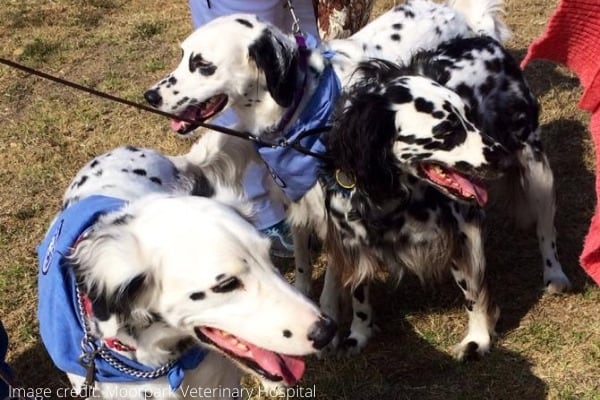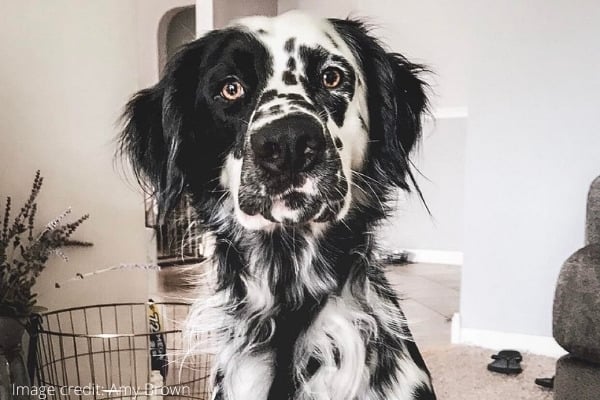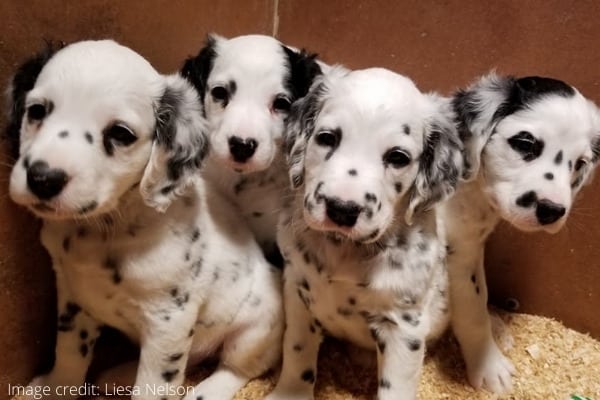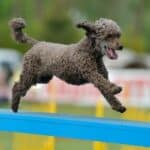
Dalmatians have always been among the most popular and widely recognized dog breeds worldwide.
If you’re a fan of the breed, you’ve probably wondered if there are other varieties that aren’t as well known or popular. Well, let’s find out.
Are there long-haired Dalmatians? Long-haired Dalmatians do indeed exist and have for many years. The long coat is the result of a recessive gene that naturally shows up in litters born to carrier parents. The coat is typically between 2 and 4 inches long with pretty feathering over the ears, tail, and legs.
In the following, we’ll explore all aspects of the long-haired Dalmatian, including what they look like, how they came to be, and whether or not they are purebred and a recognized breed.
Long-Haired Dalmatians
Dalmatians with long coats sounds like a new dog breed discovery, but the truth is, they’ve been around ever since the breed as we know now was first created.
It’s only in recent years that the long-haired version has taken over the spotlight, particularly because of the rise in demand for dogs with their fur type.
Long-Haired Dalmatians at a Glance
| General Appearance | Lean, muscular body; white, spotted body |
| Coat Length | 2-4 inches |
| Colors | White + black or liver spots |
| Size | 19-23 inches height, 45-70 pounds weight |
| Temperament | Friendly with proper socialization and training, otherwise may show aggression |
| Grooming | Daily brushing, weekly bath |
| Energy Levels | High-energy dog |
| Trainability | Intelligent and trainable |
| Average Price | $900 |
What Is a Long-Haired Dalmatian?
Long-haired Dalmatians are a variation of the more popular short-coat Dalmatian dog breed. The reason for their coat variation is a recessive gene.
Long-haired Dalmatians look exactly how you would expect upon hearing their name.
They basically look the same as any short-haired Dalmatian with their unmistakable spotting all over the body, except that they have longer hair.
What Are Long-Haired Dalmatians Called?
Long-haired Dalmatians are also called long-coat or LC Dalmatians, named after the long-coat recessive gene that makes this breed variation unique.
Are Long-Coat Dalmatians Purebred?
Since the breed standard calls for short hair, many believe that long-haired Dalmatians either don’t exist or a cross with a different dog breed with a longer coat to make a designer dog.
However, that is not the case.
The long-haired variation is a purebred Dalmatian. Every bit of them, from personality to size and health issues, is the same as the recognized purebred short-haired Dalmatians.
Are Long-Haired Dalmatians Recognized by the AKC?
No, the AKC hasn’t recognized long-haired Dalmatians as a separate dog breed or as an accepted variation of the standard.
Having a long coat is considered a violation of the Dalmatian breed standard. Despite the purebred status of long-haired Dalmatians, their long coat is seen as a product of a faulty gene.
Can Long-Coat Dalmatians Be AKC Registered?
Organizations like the AKC are famous for their strict breed standards.
According to the AKC, Dalmatians have a short, dense, fine, and close-fitting coat. It’s neither silky nor woolly but sleek, glossy, and healthy in appearance.
That description leaves no room for doubt as to what AKC accepts as a standard for the breed.
But while AKC hasn’t accepted the long-coat trait yet and any dog with this coat type would be disqualified in a show, there are plenty of competition opportunities when it comes to long-haired Dalmatians.
They can participate in dock diving, agility, and obedience competitions without being faulted for their coat.
Why Do Some Dalmatians Have Long Coat?
This breed variation is possible because of the long-coat or LC gene, which is a recessive gene. Even if one parent carries the gene, it doesn’t mean that the long coat trait will show up in the litter.
Long-haired Dalmatian puppies are only possible if two LC gene carrier Dalmatians are bred together. Even then it is not guaranteed that every pup in the litter will have a long coat.
Another important thing to note is that a puppy born as a short-coat Dalmatian, even if it’s a carrier of the LC gene, won’t be able to grow a long coat later on.
Have Long-Haired Dalmatians Always Existed?
Although plenty of people have seen long-haired Dalmatians in photos but not in real life, one may question their existence.
They do exist in real life, and they always have. Evidence suggests that they have existed since the Dalmatian breed origin back in the 1300s in Dalmatia, a region in Croatia.
Many also believe that there were two variations of Dalmatians once upon a time – those with short coats and those with long coats.
Long-Haired Dalmatian Appearance

The long-haired Dalmatian is every bit a standard Dalmatian except for the noticeably different fur.
They have the same intelligent and alert expression with moderately set, rounded eyes that range from dark to blue. They all feature a strong muzzle.
Among their most distinctive features is their gait due to their lean, long legs paired with a graceful body. It’s matched with a strong, smooth-muscled, and slightly longer tail that curves upwards.
However, the contours of their body will not be as evident as those with a short coat.
How Long Is the Coat on a Long-Haired Dalmatian?
Although they are long-haired variety, it doesn’t mean that long-haired Dalmatians have a fluffy coat that covers their entire body, like Shih-Tzus and Maltese.
They are not fluffy Dalmatians, although there is more fluffiness than with the standard Dalmatian dog.
Long-haired Dalmatians grow their coats at around 2-4 inches long in select parts of their body, particularly on the ears, legs, and tails.
What Colors Do Long-Coat Dalmatians Come In?
All Dalmatian puppies are born having pure white skin. There will be no noticeable spots until at least 10 days to three weeks after birth.
Usually, the spot color will be black or brown (liver), but some long-haired Dalmatians can have spots in varying colors and shades due to mutation.
Other possible coat colors include:
- Orange-colored spots (Orange Dalmatian)
- Pale-yellow spots (Lemon Dalmatian)
- Gray-Blue spots (Blue Dalmatian)
- Tri-colored spots, which can be any combination of white, black, and tan or white, brown, and tan (Tri-Colored Dalmatian)
Long-Haired Dalmatian Temperament
Long-coat Dalmatians make a fantastic family dog. They are friendly, gentle, loyal, and highly protective.
Their outgoing nature only comes about through proper socialization from an early age and continuous training as they grow older.
Are Long-Haired Dalmatians Aggressive?
The Dalmatian breed does get a bad rep for being an aggressive dog breed. However, this is only the case for an unsocialized and untrained dog.
Are Long-Haired Dalmatians Easy to Train?
They are an intelligent dog breed, making them quite mischievous during training. However, they are also known for their trainability as coach dogs, firehouse dogs, hunters, and circus performers.
Your approach and consistency when training will make all the difference.
Do Long-Haired Dalmatians Bark a Lot?
Long-haired Dalmatians can bark a lot. This is usually a sign of aggressive behavior stemming from poor training or boredom when their exercise requirements are not met.
Are Long-Haired Dalmatians Good Dogs?
Provided with the right care and training, long-haired Dalmatians can be the most loving, goofy, protective, and super friendly dogs you can get.
Are Long-Haired Dalmatians Good With Kids?
With early socialization and proper training, LC Dalmatians can be good with kids and show no aggression at all.
Long-Haired Dalmatian Size
They are medium-sized dogs, and like most dogs, an average male long-haired Dalmatian will be slightly bigger and taller than the female variety.
They can grow to a height that ranges from 21-23 inches, while female long-haired Dalmatians reach between 19 and 22 inches in height.
On average, long-haired Dalmatians will have an elegantly proportioned body that can grow anywhere between 45 to 70 pounds.
Long-Haired Dalmatian Price
If you’re planning to get a long-haired Dalmatian puppy, expect to pay anywhere from $600 to $1,200.
Sometimes, some breeders will price them higher, while others who only want to breed short coats for show purposes will want to get rid of their long-haired pups quickly by offering low prices.

Long-Haired Dalmatians Health Issues
In conducive environments, long-haired Dalmatians are generally healthy dogs. However, they have a higher risk of some health issues.
Common problems for long-haired Dalmatians include hearing issues, muscular weakness for senior dogs, elbow and hip dysplasia, thyroid infection, knee dislocation, and congenital or advanced cardiac issues.
Another common health issue for them is hyperuricosuria, a hereditary defect where there is an excessive excursion of uric acid in their urine.
It can lead to bladder and kidney stones when left untreated. Symptoms for this include frequent and painful urination and blood in the urine.
However, not all long-haired Dalmatians will suffer from these conditions. There’s a high probability that they will remain gorgeous and healthy without any signs of the diseases mentioned above.
Do Long-Haired Dalmatians Shed?
Dalmatians, in general, are moderate shedders, whether they have a coarse, short, or long coat.
Also, keep in mind that they don’t have a shedding season. Long-coat Dalmatians will shed all year round.
It can be quite difficult to keep a house completely free of shed hair, especially with their long coats that makes the hair more noticeable.
Vacuuming at least two to three times every week can help control the shedding.
Do Long-Haired Dalmatians Need Grooming?
While the longer hair is beautiful, long-coat Dalmatians do need a dedicated grooming routine.
Having a long-haired Dalmatian means you have to be a bit more consistent in terms of grooming them.
Daily brushing or brushing several times each week is highly recommended to help control their shedding. A dual soft bristle/pin brush is perfect.
Investing in a good pet hair vacuum will also help maintain their smooth and shiny coat.
Because of their silky, long coat, your long-haired Dalmatian will need a bath monthly or whenever you notice their coat becomes dirty.
- Developed with pawfessional groomers for everyday de-shedding, detangling and removing small mats
- Features two brushes and grooming actions in one! One side contains stainless steel tips with a...
- Pet Vacuum Cleaners for Loose Hair from Pet's Body; Patent in China USA Japan. The pet vacuum...
- Efficient loose hair cleaning. This pet grooming vacuum can clean dog or cat loose fur efficiently...
Long-Haired Dalmatians Exercise Needs
Although they are non-sporting dogs, long-haired Dalmatians are strong, active, and muscular with boundless energy.
Their exercise requirement is quite high, and owning one means walking or exercising your dog for at least two hours daily.
Otherwise, a high-energy dog like a long-haired Dalmatian may develop behavioral issues like incessant barking.
Why Are Long-Haired Dalmatians Controversial?
The whole subject of long coats in Dalmatians is controversial. Once, it was believed that the breed had a 50:50 split between types with short coats and long coats.
However, over time, some Dalmatian enthusiasts saw the long coat as a fault in the breed.
The long coat continued to appear in litters, and some breeders tried to breed expressly for the long coat, believing that it was the only way to preserve the purity of the breed.
Their overzealous actions resulted in eventual bullying of long-coat enthusiasts, causing other breeders and owners of long-haired Dalmatians to hide their pups.
There have been tales of long-coated Dalmatians being dumped or taken to rescue centers and other being euthanized to ensure that the fault in the gene would not go further.
Luckily, things have changed, especially in the last couple of years. Breeders and dog owners alike are recognizing the natural breed variation.
Seeing as there were less than a hundred of them a year ago, their number has dramatically changed in recent years.
Is There a Miniature Long-Coat Dalmatian?
There are mini-versions of long-coat Dalmatians. They can grow anywhere from 8-12 inches in height and reach about 18-24 pounds.
Before considering this breed, there are a few things to consider:
- It might not be a purebred long-haired Dalmatian. Their small size could be because a long-coat Dalmatian was crossed with a smaller breed to create a mixed designer dog.
- Some unethical breeders breed the runts of the litter to create a mini-sized dog, possibly also creating a lifetime of health problems.
- Others introduce the dwarfism gene to get miniature dogs, which also runs the risk of increased health issues.
Finding a Reputable Long-Haired Dalmatian Breeder
You should only get a long-haired Dalmatian from a reputable breeder. Before anything else, it’s smart to do diligent research and know what to look for in a breeder.
What To Look For
- Ask the breeders how the pups are handled and raised. Dalmatians, whether short or long haired, require early socialization.
- Ask for the pedigree, and the breeder should give you a clear answer without any runarounds.
- Ask the breeder for temperament information. Every ethical, good breeder will spend time with the puppies and will know this information.
- Ask them for tests: BAER hearing, OFA Eyes or PENNHIP, and even DNA panels for testing genetic conditions in puppies.
Recommended Long-Haired Dalmatian Breeders
Conclusion
Long-haired Dalmatians are playful, energetic, highly intelligent, and loyal companions, just like all Dalmatians.
What’s more, their lovely long coat and distinctive spotted trait make them absolutely adorable, but they are a highly active breed, and owning one requires a commitment, ample attention, and exercise to satisfy their energy requirements.
Image credits: Moorpark Veterinary Hospital, Liesa Nelson, Amy Brown
Last update on 2024-04-26 at 01:43 / Affiliate links / Images from Amazon Product Advertising API






